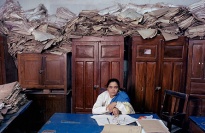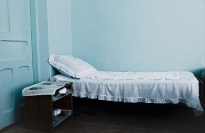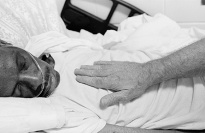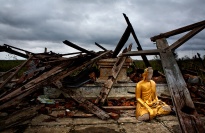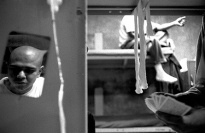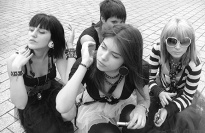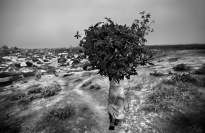About Moving Walls 17
Since 1998, the Moving Walls exhibition series has featured documentary photography that reflects the Open Society Foundations’s commitment to addressing and overcoming obstacles such as political oppression, economic instability, and racism that hinder or threaten the development of open societies.
Moving Walls 17, the 2010 Summer/Fall installment of this series, explores some of these challenges through seven bodies of work that address the relationship between those in power and those who are governed by them. As a whole, the images show how power can be used as an impediment to transparency, a mechanism for social control, and—in the worst examples—a tool for oppression, while also acknowledging the strength and defiance of people who suffer as a result.
Jan Banning’s portraits of civil servants highlight those who stand at the interface between civil administrations and the public. By photographing these government workers sitting stiffly behind their desks, Banning creates a typology of bureaucratic formality and decorum across eight countries and five continents. By using the office desk as a metaphor but also capturing some of the individual characteristics of the civil servant behind it, Banning’s images provide an insight on how bureaucracies can work to protect those in power while being operated by ordinary people.
Photographs by Mari Bastashevski, Christian Holst, and Saiful Huq Omi depict people who are living in inhospitable social and political environments. Mari Bastashevski documents the people and places left behind by the abduction and murder of citizens in the Northern Caucasus that are believed to be largely the work of military and security forces. A climate of fear and the ambivalence or obstructionism of local officials leave remaining family members with few options for recourse. The still and empty mood of the images recalls the state of isolation and limbo that result.
Christian Holst provides a glimpse into daily life in Burma under its military regime. These color-saturated images allude to a culture of neglect, censorship, and repression, while honoring the graceful resilience of the Burmese people.
Saiful Huq Omi addresses the double victimization of the Rohingya, a Muslim ethnic minority group from western Burma. Having suffered persecution, discrimination, and denial of citizenship at the hands of Burma’s military junta, many Rohingya have fled to Bangladesh. Omi documents the additional hardship they face there—both in and out of refugee camps.
In Europe, the Roma have suffered persecution, discrimination, and social exclusion throughout their history. Yet the photographs included in Chachipe: An Exploration of Roma Images and Identity, aim to challenge negative stereotypes of Roma as mere victims. Created in the context of a youth photography competition, these photographs show vibrant and playful depictions of daily life and aim to inspire a positive sense of Roma identity.
In the United States, the criminal justice system aims to uphold the law and protect civilians, but too often, over-reliance on incarceration and excessively harsh punishment have devastating consequences for individuals, families, and communities. Ara Oshagan explores this from the perspective of young people placed in youth detention facilities and adult prisons across California. He combines photographs of these young men and women with their own writings and drawings, in order to create a multilayered narrative about their experiences transitioning into adulthood within the criminal justice system.
In contrast, Lori Waselchuk focuses on people facing the end of their lives at Angola, Louisiana’s state penitentiary. In documenting the prison’s hospice program, which is run by incarcerated volunteers, Waselchuk not only shows a culture of caring and compassion that challenges stereotypes of incarcerated people, but also provides an intimate and personal perspective on what long-term and life sentences signify for those inside.
